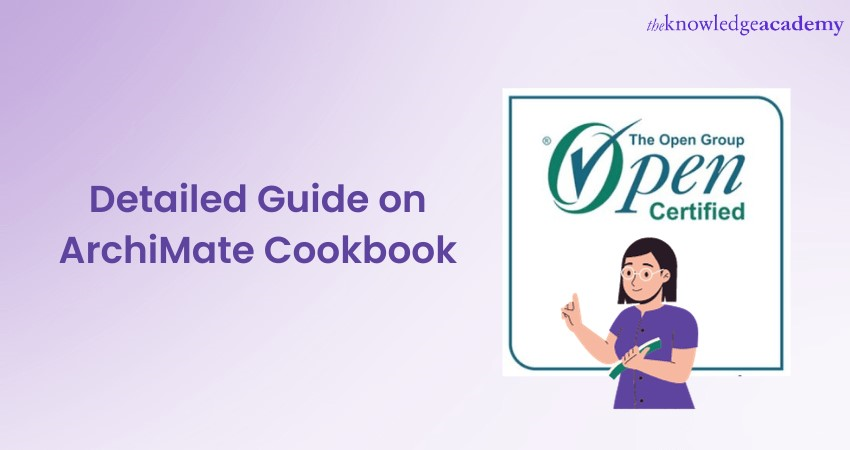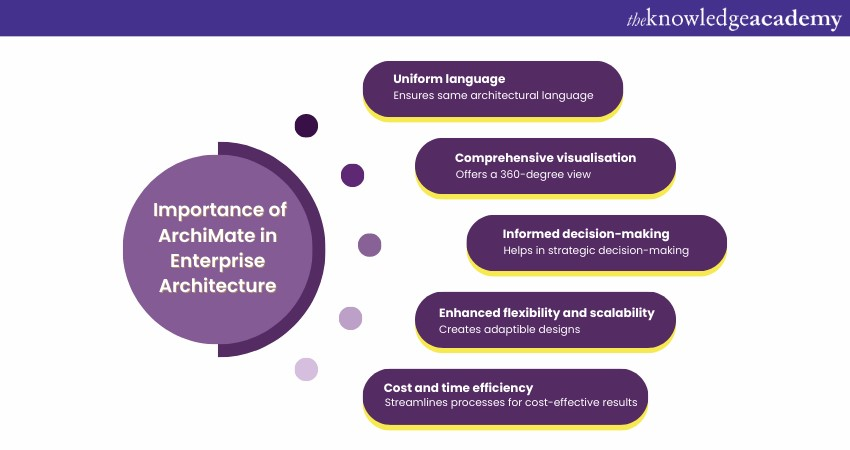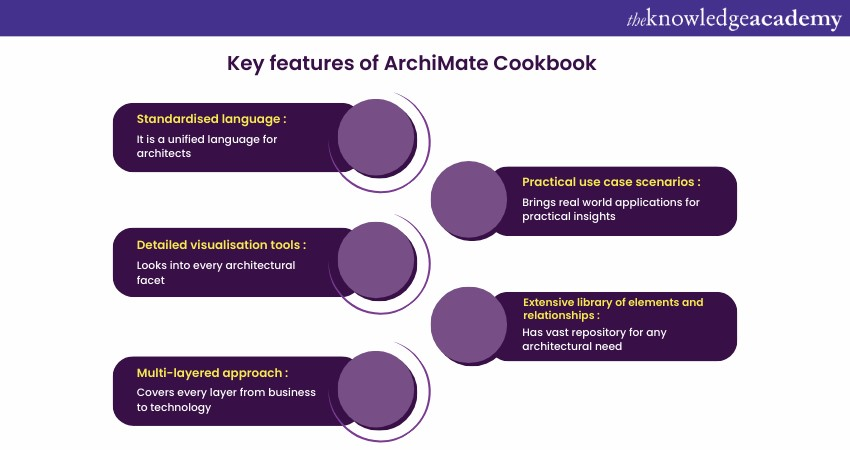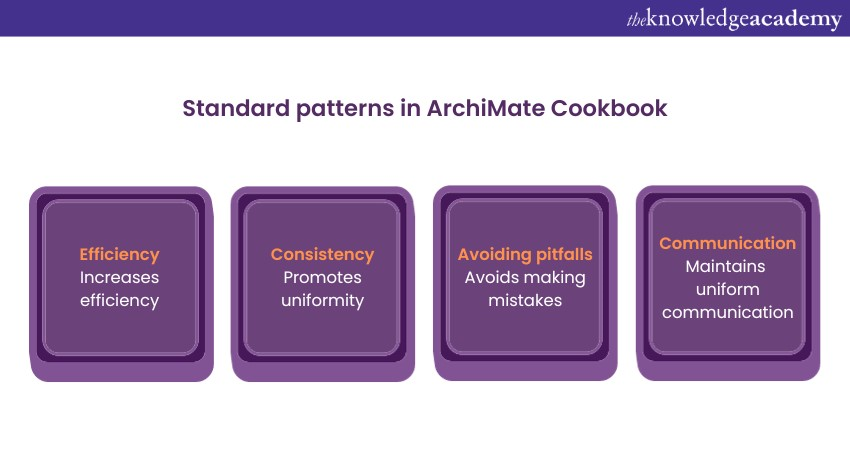We may not have the course you’re looking for. If you enquire or give us a call on +64 98874342 and speak to our training experts, we may still be able to help with your training requirements.
Training Outcomes Within Your Budget!
We ensure quality, budget-alignment, and timely delivery by our expert instructors.

ArchiMate is a universally recognised modelling language that offers clarity and precision to the often-complex realms of architectural design. If you are in Enterprise Architecture, then this Cookbook is very important for you to use in your architecture. This ArchiMate Cookbook plays intricate patterns and designs that form the foundation of modern enterprise structures.
ArchiMate is a distinguished modelling language that has already etched its mark by making architectural designs more coherent and communicable. It bridges the gap between traditional architectural practices and contemporary demands, making it a timeless resource. In this blog, you are going to learn about ArchiMate Cookbook, its importance in Enterprise Architecture, the various designs, patterns and the benefits of Cookbook. Read on further to know more!
Table of Contents
1) What is the ArchiMate Cookbook?
2) The importance of ArchiMate in Enterprise Architecture
3) Key features of ArchiMate Cookbook
4) Understanding ArchiMate Cookbook patterns and examples
a) Standard patterns
b) Advanced patterns
5) Benefits of implementing ArchiMate Cookbook Designs
6) Conclusion
What is the ArchiMate Cookbook?
The "ArchiMate Cookbook" is more than just a book. It's a comprehensive resource tailored for professionals like you. It helps you to navigate the intricate domain of Enterprise Architecture. ArchiMate is a renowned modelling language developed by The Open Group. The Cookbook is designed to offer clarity, guidance, and hands-on strategies for constructing effective architectural designs.
The Cookbook serves as a repository of patterns—predefined, tried-and-tested templates that can be applied across various architectural scenarios. Each pattern in the book is meticulously elaborated upon. This helps you to get insights into its application, benefits, and potential pitfalls. It also acknowledges the interconnectedness of various architectural elements and emphasises the importance of a cohesive, integrated design strategy.
Enhance your knowledge of Enterprise Architecture – Register now for our ArchiMate® Training .
The importance of ArchiMate in Enterprise Architecture
In this section, you will learn in detail about the importance of the ArchiMate Cookbook in Enterprise Architecture. Let’s look at these points:

1) Standardisation and consistency:
One of the primary advantages of ArchiMate is the standardisation it brings. With numerous stakeholders involved, from IT professionals to business strategists, having a unified language ensures that everyone is on the same page. This consistent approach eliminates ambiguities, reduces errors, and ensures that designs are implemented as envisioned.
2) Comprehensive framework:
ArchiMate offers a large view of the architectural environment. It covers various architectural layers - from business and application to technology. This comprehensive coverage ensures that no aspect of the enterprise's structure is overlooked, fostering a more integrated and synergistic architectural approach.
3) Visualisation and communication:
ArchiMate is inherently visual. Its diagrams provide clear, graphical representations of complex structures, making it easier for stakeholders to grasp intricate concepts. This visualisation is not just about understanding but also about effective communication. By offering a universally understood set of symbols and notations, ArchiMate ensures that architectural ideas can be easily shared, discussed, and refined.
4) Facilitating decision- making:
With its ability to represent and interlink different components of an enterprise, ArchiMate becomes an invaluable tool for decision-makers. Visualising dependencies, risks, and opportunities, it allows for better-informed decisions, ensuring alignment with both business and IT goals.
5) Flexibility and integration:
While ArchiMate has its foundational principles and notations, it’s also designed with flexibility in mind. It can be easily integrated with other standards and methodologies like The Open Group Architecture Framework (TOGAF). This flexibility ensures that organisations can adapt ArchiMate to their unique needs and existing processes,
6) Promotion of best practices:
ArchiMate doesn't just offer a language; it inherently promotes best practices in Enterprise Architecture. By following its guidelines, organisations can ensure that they are adhering to globally recognised standards of excellence. This can lead to better architectural outcomes and more efficient processes.
7) Evolution and adaptability:
Enterprise Architecture evolves with technological advancements and changing business needs. ArchiMate, with its regular updates and iterations, ensures that it remains relevant and continues to offer value even as the architectural landscape shifts.
8) Empowering collaboration:
In many organisations, there is a gap between IT teams and business units. ArchiMate bridges this gap. By providing a language that both parties understand, it fosters collaboration, ensuring that architectural designs are both technically sound and aligned with business objectives.
9) Training and skill development:
Given its global recognition, numerous training programs and certifications revolve around ArchiMate. This not only helps in skill development but also ensures that there's a consistent talent pool available for organisations seeking expertise in Enterprise Architecture.
10. Futureproofing:
ArchiMate, with its comprehensive and adaptable framework, ensures that organisations are better prepared to handle future challenges, be it integrating new technologies or pivoting to new business models.
Unlock your potential in Enterprise Architecture- Register now at our ArchiMate® 3.1 Training Course: Level 1 .
Key features of ArchiMate Cookbook
Designed to complement the robustness of the ArchiMate modelling language, the Cookbook accentuates practicality, guiding professionals in harnessing the power of ArchiMate effectively. Let's know more about its standout features:

1) Structured guidance:
One of the strengths of the Cookbook is its well-structured layout. It provides a systematic approach to architectural modelling, ensuring that practitioners can navigate through its contents with ease and find relevant patterns swiftly.
2) Real-world patterns:
Unlike some texts that remain deeply entrenched in theory, the Cookbook excels in its emphasis on real-world, actionable patterns. Each pattern is presented with comprehensive details, from its core concept to its practical application, ensuring that readers can translate theory into practice.
3) Diverse examples:
A standout feature of the Cookbook is its array of examples. These examples span different industries and scenarios, offering readers a broad perspective. This diversity aids in understanding the versatility of ArchiMate and how it can be applied across varied contexts.
4) Integration with ArchiMate versions:
The Cookbook seamlessly integrates various versions of ArchiMate. This ensures that readers are equipped with knowledge that’s both foundational and cutting-edge. This integration ensures the relevance and longevity of the content.
5) User-friendly illustrations:
Visuals play a crucial role in understanding architectural concepts. The Cookbook is replete with user-friendly diagrams, charts, and illustrations that simplify complex ideas, making them accessible even to those new to ArchiMate.
6) Expert insights:
The Cookbook isn’t just a compilation of patterns; it’s a distillation of expert insights. You can benefit from the wisdom of seasoned professionals, gaining detailed understanding and tips that can only come from years of experience in the field.
7) Interconnectedness:
Reflecting the interconnected nature of Enterprise Architecture, the Cookbook emphasises the relationships between different architectural elements. This promotes a more integrated approach to design and strategy.
8) Comprehensive index:
The Cookbook’s comprehensive index ensures that readers can quickly find topics, patterns, or examples they're interested in, making it a user-friendly reference tool.
9) Updates and additions:
The Cookbook is periodically updated. New patterns, refined strategies, and additional examples ensure that the content remains relevant in a rapidly changing landscape.
10) Practical exercises:
The Cookbook includes practical exercises. These exercises can challenge you to apply what you’ve learned. This helps you to have a deeper grasp of concepts.
Understanding ArchiMate Cookbook patterns and examples
The ArchiMate Cookbook offers a variety of patterns and examples, providing clear, hands-on guidance for Enterprise Architecture endeavours. These patterns, rooted in real-world scenarios, help in the practical applications of ArchiMate. This also helps so that the architects can seamlessly translate theory into actionable, effective designs.
Standard patterns
Standard patterns are best practices that have been distilled from numerous real-world applications. These patterns capture essential architectural knowledge, ensuring that architects don't have to 'reinvent the wheel' every time they face a common challenge. Instead, they can reference a standard pattern, adapting its principles to the specifics of their current project.
Here are some of the benefits of using standard patterns:

1) Efficiency: By utilising established patterns, architects can accelerate the design process, ensuring quicker delivery without compromising on quality.
2) Consistency: Standard patterns promote uniformity. This makes sure that different parts of an architecture or even multiple architectures share common features, making integration and maintenance smoother.
3) Avoiding pitfalls: These patterns encapsulate the wisdom of many professionals. By leveraging them, architects can sidestep common mistakes and potential pitfalls, ensuring robust designs.
4) Enhanced communication: Standard patterns, being widely recognised, form a common language that architects can use to deliver their ideas, both within their teams and with stakeholders.
Now let us look at some examples of standard patterns:
1) Layered architecture: It involves organising components into distinct layers based on their roles. This separation of concerns promotes modularity and scalability.
2) Microservices: This pattern emphasises creating small, autonomous services that can operate independently but work collectively to form a larger system. It's favoured for its flexibility and resilience.
3) Event-driven architecture: Here, the flow is determined by events, allowing for more responsive and adaptive systems.
4) Model-View-Controller (MVC): Widely used in software development, MVC separates an application into three interconnected components: the model, the view, and the controller. Hence, it helps to ensure a clean separation between data, user interface, and control logic.
Many architectural tools incorporate standard patterns into their features. These tools not only provide you with easy access to these patterns but also facilitate their adaptation and implementation. This leads to making the design process even more streamlined.
Advanced patterns
While standard patterns offer foundational frameworks, advanced patterns push the boundaries, addressing more complex, nuanced, and specific challenges. They look into architectural problems, offering solutions that are both innovative and specialised.
Now, you will see the importance of advanced patterns:
1) Complexity: As organisations grow and evolve, the challenges they face become more multifaceted. Advanced patterns cater to such multifaceted needs.
2) Innovation: With the advent of new technologies and methodologies, architects find novel ways to address challenges, leading to the development of advanced patterns.
3) Optimisation: There's a continuous pursuit to refine architectural strategies to push for efficiency and resilience, leading to advanced patterns that fine-tune existing approaches.
Let us look at some examples now:
1) Command Query Responsibility Segregation (CQRS): This pattern separates the modification and reads actions, optimising both and ensuring they can evolve independently. It's particularly beneficial in systems where high scalability is a requisite.
2) Saga pattern: In distributed systems, transactions spanning multiple services can be complex. The saga pattern breaks such transactions into smaller, more manageable parts, ensuring system consistency.
3) API gateway: As microservices architecture gains popularity, managing service-to-service communication becomes paramount. The API gateway pattern centralises entry points, streamlining requests and ensuring efficient communication.
4) Composite frontend: For user interfaces that must pull from multiple sources or services, this pattern offers a framework where each section of the UI is responsible for its data, creating a harmonious and responsive user experience.
Here are some more examples of patterns from the Cookbook:
a) Business process pattern: This pattern typically depicts how business processes are coordinated. For instance, how a customer order is processed, from receipt to delivery.
b) Application cooperation pattern: Showcases how different applications within an organisation interact and share data.
c) Infrastructure pattern: Focuses on the underlying IT infrastructure, highlighting how different servers, databases, and other tech components are interconnected.
Benefits of implementing ArchiMate Cookbook Designs
Implementing designs from the ArchiMate Cookbook offers manifold benefits to enterprises. These are the following benefits of implementing ArchiMate Cookbook Designs:
1) Standardisation across the board
a) Uniform language: The Cookbook ensures that everyone, from business stakeholders to IT professionals, speaks the same architectural language, fostering clearer communication and reducing misunderstandings.
b) Consistent documentation: By implementing standard designs, organisations ensure consistency in documentation, facilitating easier understanding and faster onboarding of new team members.
2) Comprehensive visualisation
a) Holistic view: ArchiMate Cookbook designs provide a 360-degree view of the enterprise, capturing facets from business processes to IT infrastructure.
b) Detail-oriented: While offering a broad overview, the designs also allow professionals to zoom into specific components, ensuring a detailed analysis of individual elements.
3) Improved Decision-making
a) Informed choices: With clear architectural visualisations, decision-makers are equipped with all the information they need to make strategic decisions that are in line with the organisation's goals.
b) Risk mitigation: Potential risks can be identified and addressed proactively, thanks to the comprehensive nature of the designs.
4) Enhanced flexibility and scalability
a) Futureproofing: ArchiMate Cookbook designs are structured to be adaptable. As business needs evolve, the architecture can be modified without overhauling the entire structure.
b) Modular approach: The designs promote modularity, ensuring that different components can be scaled or adapted independently.
5) Cost and time efficiency
a) Reduced redundancy: With standardised designs, organisations can avoid redundant processes and systems, leading to significant cost savings.
b) Faster time-to-market: Clear architectural roadmaps streamline project timelines, ensuring products or services reach the market faster.
6) Alignment of Business and Information Technology (IT)
a) Bridging the gap: ArchiMate Cookbook designs ensure that business objectives and IT strategies are perfectly aligned, creating a synergy that drives growth.
b) Feedback loops: The designs facilitate feedback mechanisms between business and IT, ensuring continuous improvement and alignment.
7) Facilitates stakeholder collaboration
a) Clear communication: The designs act as a visual tool for discussions, making it easier for stakeholders from various domains to understand and contribute.
b) Collaborative design: By offering a shared reference point, stakeholders can collaboratively refine and optimise the architecture.
8) Continuous improvement
a) Baseline creation: Implementing the Cookbook's designs provides organisations with a baseline architecture, serving as a reference point for future improvements.
b) Gap analysis: With a standardised architecture in place, organisations can easily identify areas of improvement, ensuring continuous refinement.
9) Empowering innovation
a) Foundation for experimentation: A standardised architecture offers a robust foundation upon which organisations can innovate, experiment with new technologies, or explore novel business models.
b) Seamless integration of new tech: With clear architectural roadmaps, integrating emerging technologies becomes more straightforward, ensuring organisations remain at the forefront of their domains.
10) Compliance and governance
a) Regulatory adherence: For industries that are heavily regulated, ArchiMate Cookbook designs ensure that architectures are compliant with necessary regulations. This reduces certain legal risks.
b) Robust governance: The designs facilitate better governance models, ensuring architectural integrity and adherence to best practices
Conclusion
ArchiMate Cookbook bridges communication gaps, drives strategic alignment, and fosters innovation. In today's dynamic business landscape, such tools are not just beneficial but essential. This helps organisations navigate complexities with clarity and foresight. You can use ArchiMate to future-proof your enterprise's architectural endeavours.
Frequently Asked Questions
Upcoming Business Improvement Resources Batches & Dates
Date
 ArchiMate® 3 Training Course
ArchiMate® 3 Training Course
Thu 23rd Jan 2025
Thu 10th Apr 2025
Thu 15th May 2025
Thu 17th Jul 2025
Thu 11th Sep 2025
Thu 13th Nov 2025







 Top Rated Course
Top Rated Course



 If you wish to make any changes to your course, please
If you wish to make any changes to your course, please


